
Frequency and Prognosis of Hydrops Fetalis: A 10-Year Single-Center Experience
Ebru Turkoglu Unal, Ali Bulbul, Evrim Kiray Bas, Sinan UsluDepartment of Neonatology, Sisli Hamidiye Etfal Training and Research Hospital, Istanbul, TurkeyObjective: The study aims to evaluate the etiological distribution and prognosis of newborn infants with hydrops fetalis (HF).
Methods: All infants born in our hospital within the past 10 years and hospitalized with the diagnosis of HF were included in this retrospective descriptive study. Demographic characteristics, etiological distributions, treatment interventions, and prognosis information of the infants were recorded retrospectively. Infants with incomplete data were excluded from the study.
Results: The mean gestational age of infants with HF was 33.6±3.1 weeks, and the mean birth weight was 2444±792 grams. Of the HF cases, 90.5% were born by cesarean section and the prenatal diagnosis rate was 42.9%. About 57.1% of the infants were intubated during resuscitation at birth in the delivery room. In the NICU, 81% of the cases were intubated and 71.4% received surfactant treatment. The most common HF findings were ascites (81%) and subcutaneous edema (81%). The most common interventional procedures were paracentesis (81%) and thoracentesis (52.4%). Exchange transfusion was performed in 2 cases (9.5%) due to immune HF. The mortality rate in the study group was 52.4%. Considering the etiological distribution of HF cases in the study group, three cases were diagnosed with immune HF (14.3%) and 18 cases with non-immune hydrops fetalis (NIHF) (85.7%). The underlying cause in immune HF cases was rhesus incompatibility. In cases with NIHF, idiopathic (23.8%) and cardiovascular diseases were the most common etiologies. A significant relationship was found between delivery room management and mortality. While the need for intubation in delivery room was significantly higher in non-survivors, the frequency of applying only positive pressure ventilation in the delivery room was significantly higher in survivors. While the rate of survival was 66.7% in immune HF cases, it was 44.4% in NIHF cases.
Conclusion: The risk of perinatal mortality in infants with HF is high depending on the underlying cause. In this study, it was determined that HF mostly developed for non-immune reasons, prenatal diagnosis and follow-up were insufficient and the interventions performed in the delivery room were an important factor in predicting mortality in the follow-up of neonates with HF.
Hidrops Fetalis Sıklığı ve Prognozu: 10 YıllıkTek Merkez Deneyimi
Ebru Turkoglu Unal, Ali Bulbul, Evrim Kiray Bas, Sinan UsluŞişli Hamidiye Etfal Eğitim ve Araştırma Hastanesi Neonatoloji Bölümü, İstanbul,Amaç: Hidrops fetalis (HF) tanısı ile yatırılarak tedavi edilen yenidoğan bebeklerin etiyolojik dağılım ve prognozunun değerlendirilmesi
Yöntem: Bu retrospektif tanımlayıcı çalışmaya, hastanemizde son on yıllık süre içerisinde doğan ve HF tanısı ile yatırılan tüm infantlar çalışmaya alındı. Bebeklerin demografik özellikleri, saptanan etiyolojik dağılımlar ile uygulanan tedavi girişimleri ve prognoz bilgileri geriye yönelik olarak kaydedildi. Bebek verileri tam olmayan infantlar çalışma dışı bırakıldı
Bulgular: Çalışmaya alınan 21 HF tanılı olgunun ortalama gestasyonel yaşı 33,6±3,1 hafta, ortalama doğum ağırlığı 2444±792 gram idi. HF olgularının %90,5i sezeryan ile doğmuştu ve prenatal tanı oranı %42,9 idi. Doğum salonunda, doğumda canlandırma uygulanan bebeklerin %57.1i entübe edilmişti. Yenidoğan Yoğun Bakım Ünitesinde %81 olgu entübe edilmiş ve %71,4ü surfaktan tedavisi almıştı. HF bulgularından en sık asit (%81) ve cilt altı ödem (%81) saptandı. Olgulara en sık girişimsel işlem olarak parasentez (%81) ve torasentez (%52,4) uygulanmıştı. İmmun HF nedeni ile 2 olguya (%9,5) kan değişimi uygulanmıştı. Çalışma grubunda mortalite %52,4 idi. Çalışma grubunda HF olgularının etyolojik dağılım değerlendirildiğinde, 3 olguda (%14,3) immun HF ve 18 olguda (%85,7) non-immun hidrops fetalis (NIHF) saptandı. İmmun HF olgularında altta yatan neden rhesus (Rh) uyuşmazlığı idi. NIHF saptanan olgularda, etyolojide en sık idiyopatik (%23.8) ve kardiovasküler hastalık (19,04%) saptandı. Doğum salonu uygulamaları ile mortalite arasında anlamlı ilişki saptandı. Kaybedilen olgularda doğumhanede entübasyon gereksinimi anlamlı yüksek iken yaşayanlarda doğumhanede sadece pozitif basınçlı ventilasyon uygulanma sıklığı anlamlı yüksek idi ( p sırasıyla; 0,017 ve0,013). İmmun HF olgularında sağkalım %66,7, NIHF olgularında sağkalım %44,4 idi.
Sonuç: Hidrops fetalis tanılı bebeklerde perinatal mortalite riski altta yatan nedene bağlı olarak yüksektir. Çalışmamızda HFin büyük bir oranda non immün nedenler ile geliştiği, prenatal tanı ve izlemin bu bebeklerde yetersiz olduğu ve doğumhanede uygulanan girişimlerin HFli yenidoğan bebeklerde mortaliteyi öngörmede etkili bir faktör olduğu saptandı. (SETB-2021-06-189)
Manuscript Language: English



















